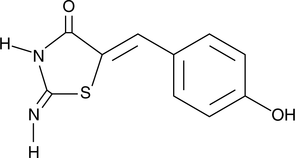Chemicals
Showing 26851–27000 of 41137 results
-
Milnacipran is an orally bioavailable serotonin and norepinephrine reuptake inhibitor (SNRI).{41447} It selectively inhibits the human serotonin transporter and norepinephrine transporter over the dopamine transporter (IC50s = 420, 77, and 6,100 nM, respectively). It also selectively inhibits sodium-dependent serotonin (Item No. 14332) and norepinephrine (Item No. 16673) uptake over dopamine (Item No. 21992) uptake in rat cerebral cortical synaptosomes (IC50s = 28.0, 29.6, and >10,000 nM, respectively).{41448} Milnacipran is an antagonist of the serotonin (5-HT) receptor subtype 5-HT3A as well as nicotinic acetylcholine receptors (nAChRs; IC50s = 63.5 and 14.3 μM, respectively) but does not inhibit other 5-HT, adrenergic, dopamine, muscarinic acetylcholine (mACh), histamine, NMDA, sigma, opioid, or GABA receptors (Kis = >10,000 nM).{41448,41449} In vivo, milnacipran (30 mg/kg) increases withdrawal threshold and latency in response to tactile and heat stimulation, respectively, in nerve-ligated mice.{41450} Formulations containing milnacipran have been used to treat fibromyalgia pain.
Brand:CaymanSKU:23837 - 50 mgAvailable on backorder
Milrinone is an inhibitor of type 3 phosphodiesterases (PDEs), inhibiting recombinant PDE3A and PDE3B with IC50 values of 0.45 and 1 μM, respectively.{19198} It is selective for PDE3 over PDE1, PDE2, PDE4, PDE5, and PDE7 (IC50s = 263, >300, 17.5, 49.1, and 58.3 μM, respectively).{19198} Milrinone (0.1-1 mg/kg) has positive inotropic effects, increasing cardiac contractile force in anesthetized dogs with a concomitant increase in heart rate but not blood pressure.{42416} It also increases contractile force in models of propranolol- and verapamil-induced heart failure in anesthetized dogs when administered at an initial dose of 30 µg/kg followed by a continuous 3 µg/kg per minute infusion. Milrinone has vasodilatory effects as well, decreasing mean aortic pressure and increasing venous compliance in anesthetized dogs when administered at an initial dose of 10 µg/kg followed by a continuous 1.7-2.4 µg/kg per minute infusion.{42417} Formulations containing milrinone have been used in the treatment of heart failure.
Brand:CaymanSKU:-Milrinone is an inhibitor of type 3 phosphodiesterases (PDEs), inhibiting recombinant PDE3A and PDE3B with IC50 values of 0.45 and 1 μM, respectively.{19198} It is selective for PDE3 over PDE1, PDE2, PDE4, PDE5, and PDE7 (IC50s = 263, >300, 17.5, 49.1, and 58.3 μM, respectively).{19198} Milrinone (0.1-1 mg/kg) has positive inotropic effects, increasing cardiac contractile force in anesthetized dogs with a concomitant increase in heart rate but not blood pressure.{42416} It also increases contractile force in models of propranolol- and verapamil-induced heart failure in anesthetized dogs when administered at an initial dose of 30 µg/kg followed by a continuous 3 µg/kg per minute infusion. Milrinone has vasodilatory effects as well, decreasing mean aortic pressure and increasing venous compliance in anesthetized dogs when administered at an initial dose of 10 µg/kg followed by a continuous 1.7-2.4 µg/kg per minute infusion.{42417} Formulations containing milrinone have been used in the treatment of heart failure.
Brand:CaymanSKU:-Milrinone is an inhibitor of type 3 phosphodiesterases (PDEs), inhibiting recombinant PDE3A and PDE3B with IC50 values of 0.45 and 1 μM, respectively.{19198} It is selective for PDE3 over PDE1, PDE2, PDE4, PDE5, and PDE7 (IC50s = 263, >300, 17.5, 49.1, and 58.3 μM, respectively).{19198} Milrinone (0.1-1 mg/kg) has positive inotropic effects, increasing cardiac contractile force in anesthetized dogs with a concomitant increase in heart rate but not blood pressure.{42416} It also increases contractile force in models of propranolol- and verapamil-induced heart failure in anesthetized dogs when administered at an initial dose of 30 µg/kg followed by a continuous 3 µg/kg per minute infusion. Milrinone has vasodilatory effects as well, decreasing mean aortic pressure and increasing venous compliance in anesthetized dogs when administered at an initial dose of 10 µg/kg followed by a continuous 1.7-2.4 µg/kg per minute infusion.{42417} Formulations containing milrinone have been used in the treatment of heart failure.
Brand:CaymanSKU:-Milrinone is an inhibitor of type 3 phosphodiesterases (PDEs), inhibiting recombinant PDE3A and PDE3B with IC50 values of 0.45 and 1 μM, respectively.{19198} It is selective for PDE3 over PDE1, PDE2, PDE4, PDE5, and PDE7 (IC50s = 263, >300, 17.5, 49.1, and 58.3 μM, respectively).{19198} Milrinone (0.1-1 mg/kg) has positive inotropic effects, increasing cardiac contractile force in anesthetized dogs with a concomitant increase in heart rate but not blood pressure.{42416} It also increases contractile force in models of propranolol- and verapamil-induced heart failure in anesthetized dogs when administered at an initial dose of 30 µg/kg followed by a continuous 3 µg/kg per minute infusion. Milrinone has vasodilatory effects as well, decreasing mean aortic pressure and increasing venous compliance in anesthetized dogs when administered at an initial dose of 10 µg/kg followed by a continuous 1.7-2.4 µg/kg per minute infusion.{42417} Formulations containing milrinone have been used in the treatment of heart failure.
Brand:CaymanSKU:-Miltefosine is an inhibitor of CTP:phosphocholine cytidylyl transferase and has antimetastatic properties.{6522,6526,6523} At concentrations of 3 and 25 µM, miltefosine inhibits proliferation of HaCaT cells (immortalized human keratinocyte cell line) by 50% and 94%, respectively.{6525} The mechanism of action of miltefosine is not well established, but the antiproliferative effect may be mediated by an increase in cellular ceramide which results in apoptosis. Treatment of cells with 25 µM miltefosine results in a 53% increase in ceramide concentration relative to control.{6525} Miltefosine is more than 90% effective in eradicating visceral infections of Leishmania species (kala azar), although the mechanism of this antiprotozoal activity is also poorly understood.{10433}
Brand:CaymanSKU:63280 - 1 gAvailable on backorder
Miltefosine is an inhibitor of CTP:phosphocholine cytidylyl transferase and has antimetastatic properties.{6522,6526,6523} At concentrations of 3 and 25 µM, miltefosine inhibits proliferation of HaCaT cells (immortalized human keratinocyte cell line) by 50% and 94%, respectively.{6525} The mechanism of action of miltefosine is not well established, but the antiproliferative effect may be mediated by an increase in cellular ceramide which results in apoptosis. Treatment of cells with 25 µM miltefosine results in a 53% increase in ceramide concentration relative to control.{6525} Miltefosine is more than 90% effective in eradicating visceral infections of Leishmania species (kala azar), although the mechanism of this antiprotozoal activity is also poorly understood.{10433}
Brand:CaymanSKU:63280 - 100 mgAvailable on backorder
Miltefosine is an inhibitor of CTP:phosphocholine cytidylyl transferase and has antimetastatic properties.{6522,6526,6523} At concentrations of 3 and 25 µM, miltefosine inhibits proliferation of HaCaT cells (immortalized human keratinocyte cell line) by 50% and 94%, respectively.{6525} The mechanism of action of miltefosine is not well established, but the antiproliferative effect may be mediated by an increase in cellular ceramide which results in apoptosis. Treatment of cells with 25 µM miltefosine results in a 53% increase in ceramide concentration relative to control.{6525} Miltefosine is more than 90% effective in eradicating visceral infections of Leishmania species (kala azar), although the mechanism of this antiprotozoal activity is also poorly understood.{10433}
Brand:CaymanSKU:63280 - 50 mgAvailable on backorder
Miltefosine is an inhibitor of CTP:phosphocholine cytidylyl transferase and has antimetastatic properties.{6522,6526,6523} At concentrations of 3 and 25 µM, miltefosine inhibits proliferation of HaCaT cells (immortalized human keratinocyte cell line) by 50% and 94%, respectively.{6525} The mechanism of action of miltefosine is not well established, but the antiproliferative effect may be mediated by an increase in cellular ceramide which results in apoptosis. Treatment of cells with 25 µM miltefosine results in a 53% increase in ceramide concentration relative to control.{6525} Miltefosine is more than 90% effective in eradicating visceral infections of Leishmania species (kala azar), although the mechanism of this antiprotozoal activity is also poorly understood.{10433}
Brand:CaymanSKU:63280 - 500 mgAvailable on backorder
MIM1 is an inhibitor of Mcl-1, an antiapoptotic Bcl-2 family protein with a role in cancer. It selectively engages the canonical groove of Mcl-1, inhibiting its ability to bind BH3 domains (IC50 = 4.7 µM).{32822} MIM1 induces caspase-3/7 activation and cell death in Mcl-1-dependent leukemia cells.{32822}
Brand:CaymanSKU:19832 -Available on backorder
MIM1 is an inhibitor of Mcl-1, an antiapoptotic Bcl-2 family protein with a role in cancer. It selectively engages the canonical groove of Mcl-1, inhibiting its ability to bind BH3 domains (IC50 = 4.7 µM).{32822} MIM1 induces caspase-3/7 activation and cell death in Mcl-1-dependent leukemia cells.{32822}
Brand:CaymanSKU:19832 -Available on backorder
MIM1 is an inhibitor of Mcl-1, an antiapoptotic Bcl-2 family protein with a role in cancer. It selectively engages the canonical groove of Mcl-1, inhibiting its ability to bind BH3 domains (IC50 = 4.7 µM).{32822} MIM1 induces caspase-3/7 activation and cell death in Mcl-1-dependent leukemia cells.{32822}
Brand:CaymanSKU:19832 -Available on backorder
Minoxidil is a pyrimidine derivative that was originally developed as an anti-hypertensive agent and unexpectedly found to stimulate hair growth. Minoxidil directly affects arteriolar smooth muscle to decrease vascular resistance in part by opening ATP-sensitive potassium channels.{24983,24984} It can activate cyclooxygenase 1 (AC50 = 80 μM), which is expressed in the dermal papilla of hair follicles, increasing prostaglandin E2 production in BALB/c 3T3 fibroblasts and human dermal papilla fibroblasts.{4171}
Brand:CaymanSKU:-Minoxidil is a pyrimidine derivative that was originally developed as an anti-hypertensive agent and unexpectedly found to stimulate hair growth. Minoxidil directly affects arteriolar smooth muscle to decrease vascular resistance in part by opening ATP-sensitive potassium channels.{24983,24984} It can activate cyclooxygenase 1 (AC50 = 80 μM), which is expressed in the dermal papilla of hair follicles, increasing prostaglandin E2 production in BALB/c 3T3 fibroblasts and human dermal papilla fibroblasts.{4171}
Brand:CaymanSKU:-Minoxidil is a pyrimidine derivative that was originally developed as an anti-hypertensive agent and unexpectedly found to stimulate hair growth. Minoxidil directly affects arteriolar smooth muscle to decrease vascular resistance in part by opening ATP-sensitive potassium channels.{24983,24984} It can activate cyclooxygenase 1 (AC50 = 80 μM), which is expressed in the dermal papilla of hair follicles, increasing prostaglandin E2 production in BALB/c 3T3 fibroblasts and human dermal papilla fibroblasts.{4171}
Brand:CaymanSKU:-Minoxidil is a pyrimidine derivative that was originally developed as an anti-hypertensive agent and unexpectedly found to stimulate hair growth. Minoxidil directly affects arteriolar smooth muscle to decrease vascular resistance in part by opening ATP-sensitive potassium channels.{24983,24984} It can activate cyclooxygenase 1 (AC50 = 80 μM), which is expressed in the dermal papilla of hair follicles, increasing prostaglandin E2 production in BALB/c 3T3 fibroblasts and human dermal papilla fibroblasts.{4171}
Brand:CaymanSKU:-Minoxidil-d10 contains 10 deuterium atoms on the piperidine ring. It is intended for use as an internal standard for the quantification of minoxidil (Item No. 15302) by GC- or LC-mass spectrometry. Minoxidil is a pyrimidine derivative that was originally developed as an anti-hypertensive agent and unexpectedly found to stimulate hair growth. Minoxidil directly affects arteriolar smooth muscle to decrease vascular resistance in part by opening ATP-sensitive potassium channels.{24983,24984} It can activate cyclooxygenase 1 (AC50 = 80 μM), which is expressed in the dermal papilla of hair follicles, increasing prostaglandin E2 production in BALB/c 3T3 fibroblasts and human dermal papilla fibroblasts.{4171}
Brand:CaymanSKU:-Available on backorder
Minoxidil-d10 contains 10 deuterium atoms on the piperidine ring. It is intended for use as an internal standard for the quantification of minoxidil (Item No. 15302) by GC- or LC-mass spectrometry. Minoxidil is a pyrimidine derivative that was originally developed as an anti-hypertensive agent and unexpectedly found to stimulate hair growth. Minoxidil directly affects arteriolar smooth muscle to decrease vascular resistance in part by opening ATP-sensitive potassium channels.{24983,24984} It can activate cyclooxygenase 1 (AC50 = 80 μM), which is expressed in the dermal papilla of hair follicles, increasing prostaglandin E2 production in BALB/c 3T3 fibroblasts and human dermal papilla fibroblasts.{4171}
Brand:CaymanSKU:-Available on backorder
Minoxidil-d10 contains 10 deuterium atoms on the piperidine ring. It is intended for use as an internal standard for the quantification of minoxidil (Item No. 15302) by GC- or LC-mass spectrometry. Minoxidil is a pyrimidine derivative that was originally developed as an anti-hypertensive agent and unexpectedly found to stimulate hair growth. Minoxidil directly affects arteriolar smooth muscle to decrease vascular resistance in part by opening ATP-sensitive potassium channels.{24983,24984} It can activate cyclooxygenase 1 (AC50 = 80 μM), which is expressed in the dermal papilla of hair follicles, increasing prostaglandin E2 production in BALB/c 3T3 fibroblasts and human dermal papilla fibroblasts.{4171}
Brand:CaymanSKU:-Available on backorder
Minoxidil-d10 contains 10 deuterium atoms on the piperidine ring. It is intended for use as an internal standard for the quantification of minoxidil (Item No. 15302) by GC- or LC-mass spectrometry. Minoxidil is a pyrimidine derivative that was originally developed as an anti-hypertensive agent and unexpectedly found to stimulate hair growth. Minoxidil directly affects arteriolar smooth muscle to decrease vascular resistance in part by opening ATP-sensitive potassium channels.{24983,24984} It can activate cyclooxygenase 1 (AC50 = 80 μM), which is expressed in the dermal papilla of hair follicles, increasing prostaglandin E2 production in BALB/c 3T3 fibroblasts and human dermal papilla fibroblasts.{4171}
Brand:CaymanSKU:-Available on backorder
MIRA-1 is a maleimide-derived small molecule that reactivates the tumor suppressor function of mutant p53, inducing apoptosis in several human solid tumor cell lines carrying tetracycline-regulated mutant p53 (IC50 = 10 µM in vitro).{30490} Treatment of tumor cells with MIRA-1 induces p21, MDM2 and PUMA in a mutant p53-dependent manner.{30490} At a concentration of 5-10 mg/kg, MIRA-1, alone or in combination with dexamethasone (Item No. 11015), arrested tumor growth in a mouse xenograft model of multiple myeloma.{30491}
Brand:CaymanSKU:-MIRA-1 is a maleimide-derived small molecule that reactivates the tumor suppressor function of mutant p53, inducing apoptosis in several human solid tumor cell lines carrying tetracycline-regulated mutant p53 (IC50 = 10 µM in vitro).{30490} Treatment of tumor cells with MIRA-1 induces p21, MDM2 and PUMA in a mutant p53-dependent manner.{30490} At a concentration of 5-10 mg/kg, MIRA-1, alone or in combination with dexamethasone (Item No. 11015), arrested tumor growth in a mouse xenograft model of multiple myeloma.{30491}
Brand:CaymanSKU:-Mirabegron is a β3-adrenergic receptor agonist (EC50 = 22.4 nM) that displays potent selectivity for β3 compared to the β1 and β2 receptor subtypes (EC50s ≥ 10 µM).{28306} It has been shown to relax rat and human bladder strips precontracted with carbamoylcholine (Item No. 14486) with EC50 values of 5.1 and 0.78 µM, respectively.{28306} Clinical trials have supported the efficacy of mirabegron in overactive bladder therapy.{28307}
Brand:CaymanSKU:-Available on backorder
Mirabegron is a β3-adrenergic receptor agonist (EC50 = 22.4 nM) that displays potent selectivity for β3 compared to the β1 and β2 receptor subtypes (EC50s ≥ 10 µM).{28306} It has been shown to relax rat and human bladder strips precontracted with carbamoylcholine (Item No. 14486) with EC50 values of 5.1 and 0.78 µM, respectively.{28306} Clinical trials have supported the efficacy of mirabegron in overactive bladder therapy.{28307}
Brand:CaymanSKU:-Available on backorder
Mirabegron is a β3-adrenergic receptor agonist (EC50 = 22.4 nM) that displays potent selectivity for β3 compared to the β1 and β2 receptor subtypes (EC50s ≥ 10 µM).{28306} It has been shown to relax rat and human bladder strips precontracted with carbamoylcholine (Item No. 14486) with EC50 values of 5.1 and 0.78 µM, respectively.{28306} Clinical trials have supported the efficacy of mirabegron in overactive bladder therapy.{28307}
Brand:CaymanSKU:-Available on backorder
Mirabegron is a β3-adrenergic receptor agonist (EC50 = 22.4 nM) that displays potent selectivity for β3 compared to the β1 and β2 receptor subtypes (EC50s ≥ 10 µM).{28306} It has been shown to relax rat and human bladder strips precontracted with carbamoylcholine (Item No. 14486) with EC50 values of 5.1 and 0.78 µM, respectively.{28306} Clinical trials have supported the efficacy of mirabegron in overactive bladder therapy.{28307}
Brand:CaymanSKU:-Available on backorder
The Mre11-Rad50-Nbs1 (MRN) complex acts as a DNA damage sensor, maintains genome stability during DNA replication, and activates and recruits ataxia-telangiectasia mutated (ATM) to damaged DNA. The genes that encode the MRN proteins are all essential for cell viability, so functional studies of MRN cannot involve deletion of these genes. Mirin is an inhibitor of MRN, inhibiting MRN-dependent phosphorylation of histone H2AX (IC50 = 66 μM).{16934} Through its effects on MRN, mirin prevents activation of ATM. Inhibition of MRN centers on the ability of mirin to block the nuclease activity of Mre11, rather than altering DNA-binding or MRN complex formation. In cells, mirin induces G2 arrest, abolishes the radiation-induced G2/M checkpoint, and prevents homology-directed repair of DNA damage.{16934}
Brand:CaymanSKU:-The Mre11-Rad50-Nbs1 (MRN) complex acts as a DNA damage sensor, maintains genome stability during DNA replication, and activates and recruits ataxia-telangiectasia mutated (ATM) to damaged DNA. The genes that encode the MRN proteins are all essential for cell viability, so functional studies of MRN cannot involve deletion of these genes. Mirin is an inhibitor of MRN, inhibiting MRN-dependent phosphorylation of histone H2AX (IC50 = 66 μM).{16934} Through its effects on MRN, mirin prevents activation of ATM. Inhibition of MRN centers on the ability of mirin to block the nuclease activity of Mre11, rather than altering DNA-binding or MRN complex formation. In cells, mirin induces G2 arrest, abolishes the radiation-induced G2/M checkpoint, and prevents homology-directed repair of DNA damage.{16934}
Brand:CaymanSKU:-The Mre11-Rad50-Nbs1 (MRN) complex acts as a DNA damage sensor, maintains genome stability during DNA replication, and activates and recruits ataxia-telangiectasia mutated (ATM) to damaged DNA. The genes that encode the MRN proteins are all essential for cell viability, so functional studies of MRN cannot involve deletion of these genes. Mirin is an inhibitor of MRN, inhibiting MRN-dependent phosphorylation of histone H2AX (IC50 = 66 μM).{16934} Through its effects on MRN, mirin prevents activation of ATM. Inhibition of MRN centers on the ability of mirin to block the nuclease activity of Mre11, rather than altering DNA-binding or MRN complex formation. In cells, mirin induces G2 arrest, abolishes the radiation-induced G2/M checkpoint, and prevents homology-directed repair of DNA damage.{16934}
Brand:CaymanSKU:-The Mre11-Rad50-Nbs1 (MRN) complex acts as a DNA damage sensor, maintains genome stability during DNA replication, and activates and recruits ataxia-telangiectasia mutated (ATM) to damaged DNA. The genes that encode the MRN proteins are all essential for cell viability, so functional studies of MRN cannot involve deletion of these genes. Mirin is an inhibitor of MRN, inhibiting MRN-dependent phosphorylation of histone H2AX (IC50 = 66 μM).{16934} Through its effects on MRN, mirin prevents activation of ATM. Inhibition of MRN centers on the ability of mirin to block the nuclease activity of Mre11, rather than altering DNA-binding or MRN complex formation. In cells, mirin induces G2 arrest, abolishes the radiation-induced G2/M checkpoint, and prevents homology-directed repair of DNA damage.{16934}
Brand:CaymanSKU:-Mirodenafil is a phosphodiesterase 5 (PDE5) inhibitor.{53073} It increases penile intracavernosal pressure (ICP) in a rat model of diabetes induced by streptozotocin (STZ; Item No. 13104) and in a rat model of cavernosal nerve injury when administered at doses of 1 and 10 mg/kg, respectively.{53073,53074} Mirodenafil (4 mg/kg per day) decreases bladder wall submucosal fibrosis and degeneration in a rat model of chronic bladder ischemia.{53075} It also decreases bladder overactivity in a female rat model of partial bladder outlet obstruction.{53076}
Brand:CaymanSKU:29045 - 1 mgAvailable on backorder
Mirodenafil is a phosphodiesterase 5 (PDE5) inhibitor.{53073} It increases penile intracavernosal pressure (ICP) in a rat model of diabetes induced by streptozotocin (STZ; Item No. 13104) and in a rat model of cavernosal nerve injury when administered at doses of 1 and 10 mg/kg, respectively.{53073,53074} Mirodenafil (4 mg/kg per day) decreases bladder wall submucosal fibrosis and degeneration in a rat model of chronic bladder ischemia.{53075} It also decreases bladder overactivity in a female rat model of partial bladder outlet obstruction.{53076}
Brand:CaymanSKU:29045 - 10 mgAvailable on backorder
Mirodenafil is a phosphodiesterase 5 (PDE5) inhibitor.{53073} It increases penile intracavernosal pressure (ICP) in a rat model of diabetes induced by streptozotocin (STZ; Item No. 13104) and in a rat model of cavernosal nerve injury when administered at doses of 1 and 10 mg/kg, respectively.{53073,53074} Mirodenafil (4 mg/kg per day) decreases bladder wall submucosal fibrosis and degeneration in a rat model of chronic bladder ischemia.{53075} It also decreases bladder overactivity in a female rat model of partial bladder outlet obstruction.{53076}
Brand:CaymanSKU:29045 - 5 mgAvailable on backorder
Mirogabalin is a calcium channel blocker with analgesic effects.{36068} It binds to the α2δ-1 and α2δ-2 subunits of voltage-dependent Ca2+ channels. Mirogabalin has potent and sustained analgesic effects (ED50 = 2.5 mg/kg) in rats with diabetes induced by streptozotocin (STZ; Item No. 13104). Mirogabalin does not inhibit activities associated with CNS adverse effects of analgesics, such as rotarod performance (ID50 = 9.4 mg/kg) or locomotor activity (ID50 = 43.9 mg/kg), at its effective dose. Formulations containing mirogabalin are in clinical trials for diabetic peripheral neuropathic pain.{36067}
Brand:CaymanSKU:22475 -Out of stock
Mirogabalin is a calcium channel blocker with analgesic effects.{36068} It binds to the α2δ-1 and α2δ-2 subunits of voltage-dependent Ca2+ channels. Mirogabalin has potent and sustained analgesic effects (ED50 = 2.5 mg/kg) in rats with diabetes induced by streptozotocin (STZ; Item No. 13104). Mirogabalin does not inhibit activities associated with CNS adverse effects of analgesics, such as rotarod performance (ID50 = 9.4 mg/kg) or locomotor activity (ID50 = 43.9 mg/kg), at its effective dose. Formulations containing mirogabalin are in clinical trials for diabetic peripheral neuropathic pain.{36067}
Brand:CaymanSKU:22475 -Out of stock
Misonidazole is a nitroimidazole with radiosensitizing and antineoplastic properties.{26220} Nitroimidazoles, including misonidazole, specifically accumulate as nitro anion radicals and their metabolites in hypoxic cells.{26220,26221,26223} The metabolites of misonidazole can themselves be cytotoxic or they can increase the chemosensitivity and radiosensitivity of the target cells.{26220} Misonidazole and derivatives, including fluoromisonidazole, are used in the imaging of hypoxic regions in tumors and in the cardiovascular system.{26223,26219,26222}
Brand:CaymanSKU:-Misonidazole is a nitroimidazole with radiosensitizing and antineoplastic properties.{26220} Nitroimidazoles, including misonidazole, specifically accumulate as nitro anion radicals and their metabolites in hypoxic cells.{26220,26221,26223} The metabolites of misonidazole can themselves be cytotoxic or they can increase the chemosensitivity and radiosensitivity of the target cells.{26220} Misonidazole and derivatives, including fluoromisonidazole, are used in the imaging of hypoxic regions in tumors and in the cardiovascular system.{26223,26219,26222}
Brand:CaymanSKU:-Misonidazole is a nitroimidazole with radiosensitizing and antineoplastic properties.{26220} Nitroimidazoles, including misonidazole, specifically accumulate as nitro anion radicals and their metabolites in hypoxic cells.{26220,26221,26223} The metabolites of misonidazole can themselves be cytotoxic or they can increase the chemosensitivity and radiosensitivity of the target cells.{26220} Misonidazole and derivatives, including fluoromisonidazole, are used in the imaging of hypoxic regions in tumors and in the cardiovascular system.{26223,26219,26222}
Brand:CaymanSKU:-Misonidazole is a nitroimidazole with radiosensitizing and antineoplastic properties.{26220} Nitroimidazoles, including misonidazole, specifically accumulate as nitro anion radicals and their metabolites in hypoxic cells.{26220,26221,26223} The metabolites of misonidazole can themselves be cytotoxic or they can increase the chemosensitivity and radiosensitivity of the target cells.{26220} Misonidazole and derivatives, including fluoromisonidazole, are used in the imaging of hypoxic regions in tumors and in the cardiovascular system.{26223,26219,26222}
Brand:CaymanSKU:-Misoprostol is an analog of prostaglandin E1 (PGE1; Item No. 13010) and an agonist of the PGE2 receptor subtypes EP2 and EP3.{8322,1752,59038} It binds to EP1, EP2, EP3-III, and EP4 receptors (Kis = 35.675, 10.249, 0.319, 5.499 μM, respectively) and is selective for EP receptors over DP, FP, IP, and TP receptors (Kis = >100 μM for all).{8322} Misoprostol inhibits electrically induced twitch contraction in isolated guinea pig ileum circular muscle and vas deferens (EC50s = 102.92 and 4.3 nM, respectively), which endogenously express high levels of EP2 and EP3 receptors, respectively.{59038,3411} It inhibits FMLP-induced superoxide anion generation in human neutrophils (EC50 = 0.35 μM).{1752} Misoprostol inhibits ethanol-induced gastric lesion formation in rats (ED50 = 0.31 μg/kg).{1754} Formulations containing misoprostol have been used in the prevention of NSAID-induced gastric ulcers.
Brand:CaymanSKU:-Misoprostol is an analog of prostaglandin E1 (PGE1; Item No. 13010) and an agonist of the PGE2 receptor subtypes EP2 and EP3.{8322,1752,59038} It binds to EP1, EP2, EP3-III, and EP4 receptors (Kis = 35.675, 10.249, 0.319, 5.499 μM, respectively) and is selective for EP receptors over DP, FP, IP, and TP receptors (Kis = >100 μM for all).{8322} Misoprostol inhibits electrically induced twitch contraction in isolated guinea pig ileum circular muscle and vas deferens (EC50s = 102.92 and 4.3 nM, respectively), which endogenously express high levels of EP2 and EP3 receptors, respectively.{59038,3411} It inhibits FMLP-induced superoxide anion generation in human neutrophils (EC50 = 0.35 μM).{1752} Misoprostol inhibits ethanol-induced gastric lesion formation in rats (ED50 = 0.31 μg/kg).{1754} Formulations containing misoprostol have been used in the prevention of NSAID-induced gastric ulcers.
Brand:CaymanSKU:-Misoprostol is an analog of prostaglandin E1 (PGE1; Item No. 13010) and an agonist of the PGE2 receptor subtypes EP2 and EP3.{8322,1752,59038} It binds to EP1, EP2, EP3-III, and EP4 receptors (Kis = 35.675, 10.249, 0.319, 5.499 μM, respectively) and is selective for EP receptors over DP, FP, IP, and TP receptors (Kis = >100 μM for all).{8322} Misoprostol inhibits electrically induced twitch contraction in isolated guinea pig ileum circular muscle and vas deferens (EC50s = 102.92 and 4.3 nM, respectively), which endogenously express high levels of EP2 and EP3 receptors, respectively.{59038,3411} It inhibits FMLP-induced superoxide anion generation in human neutrophils (EC50 = 0.35 μM).{1752} Misoprostol inhibits ethanol-induced gastric lesion formation in rats (ED50 = 0.31 μg/kg).{1754} Formulations containing misoprostol have been used in the prevention of NSAID-induced gastric ulcers.
Brand:CaymanSKU:-Misoprostol is an analog of prostaglandin E1 (PGE1; Item No. 13010) and an agonist of the PGE2 receptor subtypes EP2 and EP3.{8322,1752,59038} It binds to EP1, EP2, EP3-III, and EP4 receptors (Kis = 35.675, 10.249, 0.319, 5.499 μM, respectively) and is selective for EP receptors over DP, FP, IP, and TP receptors (Kis = >100 μM for all).{8322} Misoprostol inhibits electrically induced twitch contraction in isolated guinea pig ileum circular muscle and vas deferens (EC50s = 102.92 and 4.3 nM, respectively), which endogenously express high levels of EP2 and EP3 receptors, respectively.{59038,3411} It inhibits FMLP-induced superoxide anion generation in human neutrophils (EC50 = 0.35 μM).{1752} Misoprostol inhibits ethanol-induced gastric lesion formation in rats (ED50 = 0.31 μg/kg).{1754} Formulations containing misoprostol have been used in the prevention of NSAID-induced gastric ulcers.
Brand:CaymanSKU:-Misoprostol is a prostaglandin E1 (Item No. 13010) analog with agonist activity mediated by EP2, EP3, and EP4 receptors.{2313,1754,1752,1611} It has been shown to inhibit the formation of gastric lesions in rats (ED50 = 0.31 µg/kg),{1754} inhibit superoxide generation in human neutrophils (EC50 = 0.35 µM),{1752} and relax fetal rabbit ductus arteriosus (EC50 = 0.36 nM){1611} in a concentration dependent manner. Misoprostol is commonly used in clinical medicine for the prevention of peptic ulcer disease. It has also been used in conjunction with mifepristone (RU-486; Item No. 10006317) for the oral induction of first trimester abortion. Misoprostol contains a C-1 methyl ester and is readily absorbed and rapidly hydrolyzed in humans to the active free acid.{2313}
Brand:CaymanSKU:-Misoprostol is a prostaglandin E1 (Item No. 13010) analog with agonist activity mediated by EP2, EP3, and EP4 receptors.{2313,1754,1752,1611} It has been shown to inhibit the formation of gastric lesions in rats (ED50 = 0.31 µg/kg),{1754} inhibit superoxide generation in human neutrophils (EC50 = 0.35 µM),{1752} and relax fetal rabbit ductus arteriosus (EC50 = 0.36 nM){1611} in a concentration dependent manner. Misoprostol is commonly used in clinical medicine for the prevention of peptic ulcer disease. It has also been used in conjunction with mifepristone (RU-486; Item No. 10006317) for the oral induction of first trimester abortion. Misoprostol contains a C-1 methyl ester and is readily absorbed and rapidly hydrolyzed in humans to the active free acid.{2313}
Brand:CaymanSKU:-Misoprostol is a prostaglandin E1 (Item No. 13010) analog with agonist activity mediated by EP2, EP3, and EP4 receptors.{2313,1754,1752,1611} It has been shown to inhibit the formation of gastric lesions in rats (ED50 = 0.31 µg/kg),{1754} inhibit superoxide generation in human neutrophils (EC50 = 0.35 µM),{1752} and relax fetal rabbit ductus arteriosus (EC50 = 0.36 nM){1611} in a concentration dependent manner. Misoprostol is commonly used in clinical medicine for the prevention of peptic ulcer disease. It has also been used in conjunction with mifepristone (RU-486; Item No. 10006317) for the oral induction of first trimester abortion. Misoprostol contains a C-1 methyl ester and is readily absorbed and rapidly hydrolyzed in humans to the active free acid.{2313}
Brand:CaymanSKU:-Misoprostol is a prostaglandin E1 (Item No. 13010) analog with agonist activity mediated by EP2, EP3, and EP4 receptors.{2313,1754,1752,1611} It has been shown to inhibit the formation of gastric lesions in rats (ED50 = 0.31 µg/kg),{1754} inhibit superoxide generation in human neutrophils (EC50 = 0.35 µM),{1752} and relax fetal rabbit ductus arteriosus (EC50 = 0.36 nM){1611} in a concentration dependent manner. Misoprostol is commonly used in clinical medicine for the prevention of peptic ulcer disease. It has also been used in conjunction with mifepristone (RU-486; Item No. 10006317) for the oral induction of first trimester abortion. Misoprostol contains a C-1 methyl ester and is readily absorbed and rapidly hydrolyzed in humans to the active free acid.{2313}
Brand:CaymanSKU:-Misoprostol (free acid)-d5 contains five deuterium atoms at the 16 methyl, 17, and 17′ positions. It is intended for use as an internal standard for the quantification of misoprostol (free acid) by GC- or LC-mass spectrometry (MS). Misoprostol is a PGE1 analog with agonist activity mediated by EP2, EP3, and EP4 receptors.{2313,1754,1752,1611} It has been shown to inhibit the formation of gastric lesions in rats (ED50 = 0.31 µg/kg),{1754} inhibit superoxide generation in human neutrophils (EC50 = 0.35 µM),{1752} and relax fetal rabbit ductus arteriosus (EC50 = 0.36 nM){1611} in a concentration dependent manner. Misoprostol is commonly used in clinical medicine for the prevention of peptic ulcer disease. It has also been used in conjunction with RU-486 for the oral induction of first trimester abortion. Misoprostol contains a C-1 methyl ester and is readily absorbed and rapidly hydrolyzed in humans to the active free acid.{2313}
Brand:CaymanSKU:10010333 - 1 mgAvailable on backorder
Misoprostol (free acid)-d5 contains five deuterium atoms at the 16 methyl, 17, and 17′ positions. It is intended for use as an internal standard for the quantification of misoprostol (free acid) by GC- or LC-mass spectrometry (MS). Misoprostol is a PGE1 analog with agonist activity mediated by EP2, EP3, and EP4 receptors.{2313,1754,1752,1611} It has been shown to inhibit the formation of gastric lesions in rats (ED50 = 0.31 µg/kg),{1754} inhibit superoxide generation in human neutrophils (EC50 = 0.35 µM),{1752} and relax fetal rabbit ductus arteriosus (EC50 = 0.36 nM){1611} in a concentration dependent manner. Misoprostol is commonly used in clinical medicine for the prevention of peptic ulcer disease. It has also been used in conjunction with RU-486 for the oral induction of first trimester abortion. Misoprostol contains a C-1 methyl ester and is readily absorbed and rapidly hydrolyzed in humans to the active free acid.{2313}
Brand:CaymanSKU:10010333 - 100 µgAvailable on backorder
Misoprostol (free acid)-d5 contains five deuterium atoms at the 16 methyl, 17, and 17′ positions. It is intended for use as an internal standard for the quantification of misoprostol (free acid) by GC- or LC-mass spectrometry (MS). Misoprostol is a PGE1 analog with agonist activity mediated by EP2, EP3, and EP4 receptors.{2313,1754,1752,1611} It has been shown to inhibit the formation of gastric lesions in rats (ED50 = 0.31 µg/kg),{1754} inhibit superoxide generation in human neutrophils (EC50 = 0.35 µM),{1752} and relax fetal rabbit ductus arteriosus (EC50 = 0.36 nM){1611} in a concentration dependent manner. Misoprostol is commonly used in clinical medicine for the prevention of peptic ulcer disease. It has also been used in conjunction with RU-486 for the oral induction of first trimester abortion. Misoprostol contains a C-1 methyl ester and is readily absorbed and rapidly hydrolyzed in humans to the active free acid.{2313}
Brand:CaymanSKU:10010333 - 50 µgAvailable on backorder
MIT-PZR is a mitochondria-targeted fluorescent probe.{50317} It is aggregation-induced emission (AIE) active and displays absorption/emission maxima of 485/705 nm, respectively. MIT-PZR can be used in live cells and in vivo.
Brand:CaymanSKU:28925 - 1 mgAvailable on backorder
MIT-PZR is a mitochondria-targeted fluorescent probe.{50317} It is aggregation-induced emission (AIE) active and displays absorption/emission maxima of 485/705 nm, respectively. MIT-PZR can be used in live cells and in vivo.
Brand:CaymanSKU:28925 - 10 mgAvailable on backorder
MIT-PZR is a mitochondria-targeted fluorescent probe.{50317} It is aggregation-induced emission (AIE) active and displays absorption/emission maxima of 485/705 nm, respectively. MIT-PZR can be used in live cells and in vivo.
Brand:CaymanSKU:28925 - 5 mgAvailable on backorder
Mithramycin A is a DNA-binding, anti-tumor and neuroprotective antibiotic originally isolated from S. grieseus that has long been used as a chemotherapeutic agent. It mediates its protective function, in part, by regulating acetylation of histones or transcription factors and, thereby, chromatin accessibility to transcriptional machinery. As a selective Sp1 inhibitor, mithramycin A binds to GC rich DNA sequences, displacing Sp1 transcription factor binding to oncogene promoters, which inhibits their expression.{20905,20901} Mithramycin A (at 10-200 nM) can sensitize tumor cells to TRAIL-induced apoptosis and has been used to selectively target tumor cells in many different cancer models.{20904,20903,20902}
Brand:CaymanSKU:11434 - 1 mgAvailable on backorder
Mithramycin A is a DNA-binding, anti-tumor and neuroprotective antibiotic originally isolated from S. grieseus that has long been used as a chemotherapeutic agent. It mediates its protective function, in part, by regulating acetylation of histones or transcription factors and, thereby, chromatin accessibility to transcriptional machinery. As a selective Sp1 inhibitor, mithramycin A binds to GC rich DNA sequences, displacing Sp1 transcription factor binding to oncogene promoters, which inhibits their expression.{20905,20901} Mithramycin A (at 10-200 nM) can sensitize tumor cells to TRAIL-induced apoptosis and has been used to selectively target tumor cells in many different cancer models.{20904,20903,20902}
Brand:CaymanSKU:11434 - 5 mgAvailable on backorder
Mitiglinide is an inhibitor of sulfonylurea receptor 1 (SUR1) linked to ATP-sensitive potassium channel Kir6.2 (IC50 = 4 nM).{54249} It is selective for SUR1/Kir6.2 over SUR2A/Kir6.2 and SUR2B/Kir6.2 channels (IC50s = 3 and 5 µM, respectively). Mitiglinide induces insulin release in HIT-T15 insulinoma cells and isolated mouse pancreatic islets when used at a concentration of 100 µM.{54250} Oral administration of mitiglinide (1, 3, and 10 mg/kg) increases postprandial plasma insulin levels and inhibits postprandial increases in plasma glucose levels in a rat model of diabetes induced by streptozotocin (STZ; Item No. 13104).{54251}
Brand:CaymanSKU:30693 - 100 mgAvailable on backorder
Mitiglinide is an inhibitor of sulfonylurea receptor 1 (SUR1) linked to ATP-sensitive potassium channel Kir6.2 (IC50 = 4 nM).{54249} It is selective for SUR1/Kir6.2 over SUR2A/Kir6.2 and SUR2B/Kir6.2 channels (IC50s = 3 and 5 µM, respectively). Mitiglinide induces insulin release in HIT-T15 insulinoma cells and isolated mouse pancreatic islets when used at a concentration of 100 µM.{54250} Oral administration of mitiglinide (1, 3, and 10 mg/kg) increases postprandial plasma insulin levels and inhibits postprandial increases in plasma glucose levels in a rat model of diabetes induced by streptozotocin (STZ; Item No. 13104).{54251}
Brand:CaymanSKU:30693 - 250 mgAvailable on backorder
Mitiglinide is an inhibitor of sulfonylurea receptor 1 (SUR1) linked to ATP-sensitive potassium channel Kir6.2 (IC50 = 4 nM).{54249} It is selective for SUR1/Kir6.2 over SUR2A/Kir6.2 and SUR2B/Kir6.2 channels (IC50s = 3 and 5 µM, respectively). Mitiglinide induces insulin release in HIT-T15 insulinoma cells and isolated mouse pancreatic islets when used at a concentration of 100 µM.{54250} Oral administration of mitiglinide (1, 3, and 10 mg/kg) increases postprandial plasma insulin levels and inhibits postprandial increases in plasma glucose levels in a rat model of diabetes induced by streptozotocin (STZ; Item No. 13104).{54251}
Brand:CaymanSKU:30693 - 50 mgAvailable on backorder
Mitiglinide is an inhibitor of sulfonylurea receptor 1 (SUR1) linked to ATP-sensitive potassium channel Kir6.2 (IC50 = 4 nM).{54249} It is selective for SUR1/Kir6.2 over SUR2A/Kir6.2 and SUR2B/Kir6.2 channels (IC50s = 3 and 5 µM, respectively). Mitiglinide induces insulin release in HIT-T15 insulinoma cells and isolated mouse pancreatic islets when used at a concentration of 100 µM.{54250} Oral administration of mitiglinide (1, 3, and 10 mg/kg) increases postprandial plasma insulin levels and inhibits postprandial increases in plasma glucose levels in a rat model of diabetes induced by streptozotocin (STZ; Item No. 13104).{54251}
Brand:CaymanSKU:30693 - 500 mgAvailable on backorder
MitoB is a ratiometric mass spectrometry probe that can be used for assessing changes in H2O2 within mitochondria in vivo. MitoB contains a triphenylphosphonium cation component that drives its accumulation in mitochondria where its arylboronic moiety selectively reacts with H2O2 to produce a phenol product, MitoP.{27787,27786} Quantifying the MitoP/MitoB ratio by LC-MS/MS reflects the mitochondrial matrix H2O2 concentration.
Brand:CaymanSKU:-Out of stock
MitoB is a ratiometric mass spectrometry probe that can be used for assessing changes in H2O2 within mitochondria in vivo. MitoB contains a triphenylphosphonium cation component that drives its accumulation in mitochondria where its arylboronic moiety selectively reacts with H2O2 to produce a phenol product, MitoP.{27787,27786} Quantifying the MitoP/MitoB ratio by LC-MS/MS reflects the mitochondrial matrix H2O2 concentration.
Brand:CaymanSKU:-Out of stock
MitoB is a ratiometric mass spectrometry probe that can be used for assessing changes in H2O2 within mitochondria in vivo. MitoB contains a triphenylphosphonium cation component that drives its accumulation in mitochondria where its arylboronic moiety selectively reacts with H2O2 to produce a phenol product, MitoP.{27787,27786} Quantifying the MitoP/MitoB ratio by LC-MS/MS reflects the mitochondrial matrix H2O2 concentration.
Brand:CaymanSKU:-Out of stock
MitoB is a ratiometric mass spectrometry probe that can be used for assessing changes in H2O2 within mitochondria in vivo. MitoB contains a triphenylphosphonium cation component that drives its accumulation in mitochondria where its arylboronic moiety selectively reacts with H2O2 to produce a phenol product, MitoP.{27787,27786} Quantifying the MitoP/MitoB ratio by LC-MS/MS reflects the mitochondrial matrix H2O2 concentration.
Brand:CaymanSKU:-Out of stock
Mitomycin A is a bacterial metabolite originally isolated from S. caespitosus.{48336} It reduces migration inhibition factor (MIF) production by isolated human lymphocytes when used at a concentration of 0.25 µg/ml and decreases spontaneous migration of WEHI-3 murine monocytes when used at concentrations of 0.5 and 5 µg/ml.{48337} Mitomycin A forms intra- and interstrand adducts with DNA in the presence of thiols, such as dithiothreitol (DTT).{48338} It reduces tumor growth in P388 leukemia and B16 melanoma mouse models with a minimum effective dose (MED) of 0.05 mg/kg for both but is toxic to mice with an LD50 value of 2 mg/kg.{48339,48336}
Brand:CaymanSKU:20915 -Out of stock
Mitomycin A is a bacterial metabolite originally isolated from S. caespitosus.{48336} It reduces migration inhibition factor (MIF) production by isolated human lymphocytes when used at a concentration of 0.25 µg/ml and decreases spontaneous migration of WEHI-3 murine monocytes when used at concentrations of 0.5 and 5 µg/ml.{48337} Mitomycin A forms intra- and interstrand adducts with DNA in the presence of thiols, such as dithiothreitol (DTT).{48338} It reduces tumor growth in P388 leukemia and B16 melanoma mouse models with a minimum effective dose (MED) of 0.05 mg/kg for both but is toxic to mice with an LD50 value of 2 mg/kg.{48339,48336}
Brand:CaymanSKU:20915 -Out of stock
Mitomycin A is a bacterial metabolite originally isolated from S. caespitosus.{48336} It reduces migration inhibition factor (MIF) production by isolated human lymphocytes when used at a concentration of 0.25 µg/ml and decreases spontaneous migration of WEHI-3 murine monocytes when used at concentrations of 0.5 and 5 µg/ml.{48337} Mitomycin A forms intra- and interstrand adducts with DNA in the presence of thiols, such as dithiothreitol (DTT).{48338} It reduces tumor growth in P388 leukemia and B16 melanoma mouse models with a minimum effective dose (MED) of 0.05 mg/kg for both but is toxic to mice with an LD50 value of 2 mg/kg.{48339,48336}
Brand:CaymanSKU:20915 -Out of stock
Mitomycin C (MMC) is an antitumor antibiotic that was discovered as a fermentation product of S. caespitosus.{20830} As an alkylating agent, its activity depends on reductive activation either through low pH or DT-diaphorase or NADH cytochrome c reductase.{20829} Activated MMC crosslinks double stranded DNA and is widely used as a tool to selectively inhibit DNA synthesis and mutagenensis, to stimulate genetic recombination, chromosome breakage and sister chromatid exchange, and to induce DNA repair.{20826,20827} MMC has clinical significance in combination cancer chemotherapy of solid tumors as well as for modulating wound healing after ophthalmological surgeries and in the management of various corneal disorders.{20828,20831}
Brand:CaymanSKU:11435 - 10 mgAvailable on backorder
Mitomycin C (MMC) is an antitumor antibiotic that was discovered as a fermentation product of S. caespitosus.{20830} As an alkylating agent, its activity depends on reductive activation either through low pH or DT-diaphorase or NADH cytochrome c reductase.{20829} Activated MMC crosslinks double stranded DNA and is widely used as a tool to selectively inhibit DNA synthesis and mutagenensis, to stimulate genetic recombination, chromosome breakage and sister chromatid exchange, and to induce DNA repair.{20826,20827} MMC has clinical significance in combination cancer chemotherapy of solid tumors as well as for modulating wound healing after ophthalmological surgeries and in the management of various corneal disorders.{20828,20831}
Brand:CaymanSKU:11435 - 25 mgAvailable on backorder
Mitomycin C (MMC) is an antitumor antibiotic that was discovered as a fermentation product of S. caespitosus.{20830} As an alkylating agent, its activity depends on reductive activation either through low pH or DT-diaphorase or NADH cytochrome c reductase.{20829} Activated MMC crosslinks double stranded DNA and is widely used as a tool to selectively inhibit DNA synthesis and mutagenensis, to stimulate genetic recombination, chromosome breakage and sister chromatid exchange, and to induce DNA repair.{20826,20827} MMC has clinical significance in combination cancer chemotherapy of solid tumors as well as for modulating wound healing after ophthalmological surgeries and in the management of various corneal disorders.{20828,20831}
Brand:CaymanSKU:11435 - 5 mgAvailable on backorder
Mitomycin C (MMC) is an antitumor antibiotic that was discovered as a fermentation product of S. caespitosus.{20830} As an alkylating agent, its activity depends on reductive activation either through low pH or DT-diaphorase or NADH cytochrome c reductase.{20829} Activated MMC crosslinks double stranded DNA and is widely used as a tool to selectively inhibit DNA synthesis and mutagenensis, to stimulate genetic recombination, chromosome breakage and sister chromatid exchange, and to induce DNA repair.{20826,20827} MMC has clinical significance in combination cancer chemotherapy of solid tumors as well as for modulating wound healing after ophthalmological surgeries and in the management of various corneal disorders.{20828,20831}
Brand:CaymanSKU:11435 - 50 mgAvailable on backorder
MitoP is a phenol product produced by the reaction of H2O2 with the ratiometric mass spectrometry probe MitoB (Item No. 17116). MitoB contains a triphenylphosphonium cation component that drives its accumulation in mitochondria where its arylboronic moiety selectively reacts with H2O2 to produce MitoP.{27786,27787} Quantifying the MitoP/MitoB ratio by LC-MS/MS reflects the mitochondrial matrix H2O2 concentration.
Brand:CaymanSKU:-Out of stock
MitoP is a phenol product produced by the reaction of H2O2 with the ratiometric mass spectrometry probe MitoB (Item No. 17116). MitoB contains a triphenylphosphonium cation component that drives its accumulation in mitochondria where its arylboronic moiety selectively reacts with H2O2 to produce MitoP.{27786,27787} Quantifying the MitoP/MitoB ratio by LC-MS/MS reflects the mitochondrial matrix H2O2 concentration.
Brand:CaymanSKU:-Out of stock
MitoP is a phenol product produced by the reaction of H2O2 with the ratiometric mass spectrometry probe MitoB (Item No. 17116). MitoB contains a triphenylphosphonium cation component that drives its accumulation in mitochondria where its arylboronic moiety selectively reacts with H2O2 to produce MitoP.{27786,27787} Quantifying the MitoP/MitoB ratio by LC-MS/MS reflects the mitochondrial matrix H2O2 concentration.
Brand:CaymanSKU:-Out of stock
MitoP is a phenol product produced by the reaction of H2O2 with the ratiometric mass spectrometry probe MitoB (Item No. 17116). MitoB contains a triphenylphosphonium cation component that drives its accumulation in mitochondria where its arylboronic moiety selectively reacts with H2O2 to produce MitoP.{27786,27787} Quantifying the MitoP/MitoB ratio by LC-MS/MS reflects the mitochondrial matrix H2O2 concentration.
Brand:CaymanSKU:-Out of stock
MitoPBN is a mitochondria-targeted antioxidant.{30308} It accumulates in the mitochondria following the generation of a mitochondrial membrane potential by succinate, an effect that is blocked by addition of the mitochondrial membrane potential uncoupler FCCP (Item No. 15218). MitoPBN inhibits superoxide activation of mitochondrial uncoupling protein 1 (UCP1), UCP2, and UCP3 when used at a concentration of 250 nM in vitro but does not react with superoxide. It traps hydroxyl (IC50 = ~77 µM) and carbon-centered radicals and inhibits the initiation of lipid peroxidation in isolated bovine heart mitochondria.
Brand:CaymanSKU:-Available on backorder
MitoPerOx is a ratiometric fluorescent probe that can be used to assess changes in lipid peroxidation within mitochondria.{30348} It is composed of a BODIPY fluorophore conjugated via a dienyl link to a triphenylphosphonium cation component that drives its accumulation in mitochondria. MitoPerOx displays an excitation maximum of 495 nm and exhibits a shift in emission maxima from 590 to 520 nm upon mitochondrial lipid peroxidation, enabling determination of ratiometric measurements of lipid peroxidation in live cells.
Brand:CaymanSKU:-Available on backorder
MitoPQ is comprised of a triphenylphosphonium lipophilic cation conjugated to the redox cycler paraquat.{30305} Driven by membrane potential, it accumulates selectively in the mitochondrial matrix where it produces superoxide by redox cycling at the flavin site of complex I.{30305} Thus, MitoPQ selectively increases superoxide production within mitochondria and can be used as a tool either in cells or in vivo to investigate the role of mitochondrial superoxide in pathology and redox signaling.{30305}
Brand:CaymanSKU:-Available on backorder
MitoPQ is comprised of a triphenylphosphonium lipophilic cation conjugated to the redox cycler paraquat.{30305} Driven by membrane potential, it accumulates selectively in the mitochondrial matrix where it produces superoxide by redox cycling at the flavin site of complex I.{30305} Thus, MitoPQ selectively increases superoxide production within mitochondria and can be used as a tool either in cells or in vivo to investigate the role of mitochondrial superoxide in pathology and redox signaling.{30305}
Brand:CaymanSKU:-Available on backorder
Mitoquinol is a mitochondria-targeted antioxidant and reduced form of mitoquinone (Item No. 29317).{11103} It reduces hydrogen peroxide production in succinate-fueled isolated bovine aortic endothelial mitochondria.{61050}
Brand:CaymanSKU:89950 - 1 mgAvailable on backorder
Mitoquinol is a mitochondria-targeted antioxidant and reduced form of mitoquinone (Item No. 29317).{11103} It reduces hydrogen peroxide production in succinate-fueled isolated bovine aortic endothelial mitochondria.{61050}
Brand:CaymanSKU:89950 - 10 mgAvailable on backorder
Mitoquinol is a mitochondria-targeted antioxidant and reduced form of mitoquinone (Item No. 29317).{11103} It reduces hydrogen peroxide production in succinate-fueled isolated bovine aortic endothelial mitochondria.{61050}
Brand:CaymanSKU:89950 - 25 mgAvailable on backorder

























